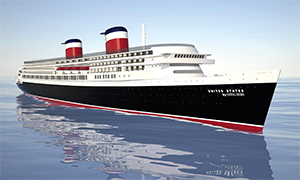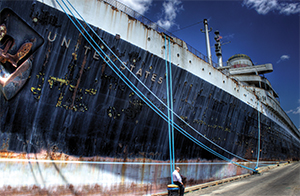Technical difficulties and projected high costs have scuttled a plan to reconstruct the historic ocean liner SS United States and return it to sea as a luxury cruise ship.
After a six-month feasibility study, Crystal Cruises, which had announced its intention to buy and retrofit “America’s flagship,” said in early August that the ship is structurally sound but the rehabilitation to sailing condition was not practical.
That means the SS United States Conservancy, which owns the 990-foot ship docked in Philadelphia for two decades, will resume trying to find a location to redevelop the vessel as a museum, hotel and events space. New York has been the preferred location.
While not exercising its option to buy the ship, Crystal will make a $350,000 donation to help the conservancy keep the ship afloat while seeking a new solution.
In February, Crystal and the conservancy announced the unprecedented plan to convert the iconic 1950s vessel into a modern luxury cruise ship that would comply with all current safety and technical standards. The cruise line then commenced a $1 million feasibility study headed by retired U.S. Coast Guard Rear Adm. Tim Sullivan.
“Unfortunately, the hurdles that would face us when trying to bring a 65-year-old vessel up to modern safety, design and international regulatory compliance have proven just too great to clear in both a technically and commercially responsible manner,” Crystal President and CEO Edie Rodriguez said in a joint statement with the conservancy.
Susan Gibbs, the conservancy’s executive director, added that “the studies performed have confirmed the ship is structurally sound. America’s flagship continues to hold enormous potential as a stationary mixed-use development and museum in New York or another urban waterfront setting.”
Sullivan, who inspected many ships for the Coast Guard during his career, said he was hoping the feasibility study would show that the project was doable, although he thought from the outset it was a long shot. He said the study showed there were serious technical, financial and regulatory problems with the conversion.
A 25 percent reconstruction of the hull would have been necessary for the installation of a modern diesel-electric propulsion system, along with bow and stern thrusters. The ship also would have needed increased ballast for stability and a smoother ride that current-day passengers expect.
He said trying to add several hundred modern staterooms with balconies high up on the ship was an issue because the new construction could have made the ship top-heavy and less stable. “Most of the ship above the waterline is aluminum, so you had a very light superstructure,” he said. “If you’re going to make it a commercial entity, you’re going to have to put a lot of weight on top.”
 |
|
The refurbished ship would have included balconies that could have made it top-heavy. |
|
Courtesy SS United States Conservancy |
The riveted hull was also an issue. The use of rivets above and below the waterline rather than welds meant the ship probably would have been dry-docked for several weeks a year for inspection, reducing the time spent at sea earning money. Replacing the underwater riveted areas with welded plates was an option but added to the expense.
Sullivan also said that Gibbs’ concern for safety required many smaller compartments to contain fires and prevent flooding, but those extra bulkheads would have made reconfiguration of the vessel harder and more expensive. He noted that the study group tested all of the watertight doors and found they all still work perfectly, “which is pretty impressive,” he said.
“Their intention for them to do the majority of the work at their own shipyards in Germany” would have made the project more economical, Sullivan said, but there were “obvious concerns” about complying with the Jones Act.
Crystal’s technical team conducted underwater inspections of the hull, examinations of its fuel and saltwater ballasting tanks, and three-dimensional scans of the entire vessel. During the study, the company paid the $60,000 monthly carrying charges to keep the ship docked in Philadelphia.
Rodriguez said the company would donate $350,000 because “we firmly believe the SS United States is an American treasure and deserves to be preserved and redeveloped as a stationary destination for future generations to experience and enjoy.”
Gibbs, granddaughter of the ship’s designer, William Francis Gibbs, said, “Thanks to this contribution — and to our members — the SS United States is not in immediate danger.”
The conservancy, which acquired the ship five years ago, will restart its search for qualified developers and investors interested in making the ship a stationary exhibit like Queen Mary in Long Beach, Calif.
When Crystal and the conservancy announced the plan, Rodriguez said rebuilding the vessel with its entirely gutted interior would cost in excess of $700 million.
SS United States’ maiden voyage in 1952 set the record for the fastest trans-Atlantic passenger ship crossing, a mark that still stands. Its role superseded by passenger jets, the ship was taken out of service in 1969.

